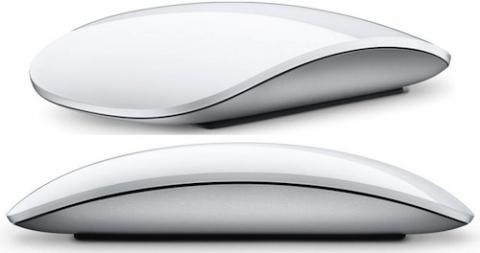
Apple Lost an Opportunity to Innovate with Magic Mouse
Steve Jobs has finally done it with Apple's new Magic Mouse: the product is devoid of buttons. Instead of the usual left and right click with a scroll wheel, the Magic Mouse has a single shell that recognizes multitouch gestures across almost its entire surface, adding a new tactile dimension to the standard keyboard & mouse combo. Actually, the Magic Mouse's biggest problem may be that it's still just a mouse.
Apple's track record with mice is mixed. The company didn't invent the mouse, but made it an integral part of computing on its early operating system's graphical user interface. In contrast to this visionary inclusion of the mouse in the 80s, Apple made several pointer blunders in the 90s. Their first USB mouse, not so fondly remembered as the "hockey puck" mouse, was an ergonomic disaster. And although PCs adopted a two button mouse early, Apple's mouse resisted the trend and continued to rely on a single button throughout the 90s. In fact, it wasn't until 2005, with the release of the Mighty Mouse—a mouse designed with two touch sensors underneath a single shell—that Apple supported a right click in their mouse.
The Magic Mouse takes several design cues from the Mighty Mouse. They both have a single shell top, which functions as the click mechanism by resting on a cantilever and moving against the mouse's body. But the Magic Mouse sheds the squeezable side button and scroll ball of the Mighty Mouse in favor of multitouch sensors underlying the acrylic shell. The Magic Mouse is longer, a little thinner, and its height is about 30% shorter than the Mighty Mouse. Compared to the Mighty Mouse, the Magic Mouse is also significantly lighter, with most of the weight attributed to the batteries. This is immediately noticeable; the wireless Mighty Mouse is back heavy, but the Magic Mouse is nicely balanced and easy to move across the desk surface. It feels light and responsive in one's hand.
With a single shell, the Magic Mouse interprets a left or right click based on finger position: one finger on the left or center of the mouse is a left click, as are two or more fingers. A single finger on the right of the mouse is a right click. The entire surface is used to scroll around documents. The loss of the Mighty Mouse's middle click and squeeze functions is regrettable, as they can be assigned to expose and spaces, two useful UI tricks, but their loss is made up for by the Magic Mouse's sensitive surface.
The Magic Mouse brings additional tactile information to the user. Scrolling through documents and websites in Safari is smooth and maps well to the soft surface of the Magic Mouse. A flick of the finger results in an appropriate response on screen, complete with the now-familiar inertia that gives pages and displayed data a feeling of mass. The sensors under the acrylic currently support two finger swipe gestures, and there is no reason to think they cannot support additional two or three finger gestures. Hopefully it's just a matter of time before third party drivers and software enable this. Firefox doesn't support multitouch gestures with the Magic Mouse yet, and there don't appear to be plugins that provide that function either. [Editor's note: Firefox 3.5 and above will support multitouch gestures on the Magic Mouse.]
After a few days' use, the Magic Mouse is quickly becoming a favorite pointing device, but it only took a few minutes with the mouse to see that Apple clearly lost an opportunity to shake up the industry with an innovative UI device. The first time I held the Magic Mouse, I realized it almost felt more comfortable as a handheld pointer like the Wii remote, than as a traditional mouse. With the addition of a gyroscope like the one embedded in the iPhone, a device could detect when it is picked up, versus when it is used on the desktop. The multitouch surface could be used like a regular MacBook trackpad, with additional gestures made by moving the mouse in the air like a Wii remote.
While it feels great and provides an excellent interface experience as it is, the Magic Mouse could be much more. It includes some next generation technology, but is held back by the limited form factor of the mouse. Fanboys and girls will need to keep their fingers crossed until after the iTablet is released.

